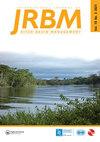Potential predictability of suspended sediment concentration in the data constrained regions of the Mahanadi River basin, Eastern India
IF 1.9
Q3 WATER RESOURCES
International Journal of River Basin Management
Pub Date : 2021-12-16
DOI:10.1080/15715124.2021.2016782
引用次数: 2
Abstract
ABSTRACT The study proposes an efficient method to evaluate the suspended sediment concentration (SSC) relative to the traditional sediment rating curves (SRC) for gauged stations and subsequently to predict the SSC in ungauged stations of a major river basin. Multiple environmental control parameters were collected from 16 stations along the Mahanadi River basin (MRB) during the monsoon season. The hysteresis behaviour of SSC is assessed and therefore considered for modelling SSC using linear mixed-effects modelling (LMM). A basin-scale rating model is proposed using principal component analysis and stepwise multiple linear regression for estimating the unmeasured SSC. The findings show that the MRB acts differently in terms of hysteresis, with distinct dilution and flushing regimes in SRC. LMM outscored SRC by nearly doubling the mean covariance and notably reducing the percent bias between observed and predicted data across stations. However, unlike LMM, SRC could not correctly estimate low and high SSCs of ≤ 0.05 g/l and ≥ 1.5 g/l, respectively. The error metrics of the proposed rating model are within acceptable limits for all ungauged stations. Nevertheless, its efficiency varies due to smaller catchment areas, non-linearity in sediment transport with respect to catchment area, and other sampling issues. As a result, compared to other known models applied on the MRB, this model has the lowest error and seems to be the best in predicting monthly SSC.印度东部马哈纳迪河流域数据受限区域悬浮泥沙浓度的潜在可预测性
摘要本研究提出了一种有效的方法来评估测量站的悬浮泥沙浓度(SSC)相对于传统的定沙曲线(SRC),并随后预测主要流域未测量站的SSC。在季风季节,从马哈纳迪河流域(MRB)沿线的16个站点收集了多个环境控制参数。对SSC的滞后行为进行了评估,因此考虑使用线性混合效应建模(LMM)对SSC进行建模。采用主成分分析和逐步多元线性回归方法,建立了流域尺度的SSC评价模型。研究结果表明,MRB在滞后方面的作用不同,SRC具有不同的稀释和冲洗制度。LMM的平均协方差几乎翻了一番,显著降低了各站观测数据和预测数据之间的百分比偏差,从而使SRC的得分超过SRC。然而,与LMM不同,SRC不能正确估计 ≤ 0.05 g/l和 ≥ 分别为1.5克/升。所提出的评级模型的误差度量在所有未加计量站的可接受范围内。然而,由于集水区较小、相对于集水区的泥沙输送非线性以及其他采样问题,其效率各不相同。因此,与应用于MRB的其他已知模型相比,该模型的误差最小,并且似乎在预测月度SSC方面最好。
本文章由计算机程序翻译,如有差异,请以英文原文为准。
求助全文
约1分钟内获得全文
求助全文
来源期刊

International Journal of River Basin Management
WATER RESOURCES-
CiteScore
6.00
自引率
4.00%
发文量
48
期刊介绍:
include, but are not limited to new developments or applications in the following areas: AREAS OF INTEREST - integrated water resources management - watershed land use planning and management - spatial planning and management of floodplains - flood forecasting and flood risk management - drought forecasting and drought management - floodplain, river and estuarine restoration - climate change impact prediction and planning of remedial measures - management of mountain rivers - water quality management including non point source pollution - operation strategies for engineered river systems - maintenance strategies for river systems and for structures - project-affected-people and stakeholder participation - conservation of natural and cultural heritage
 求助内容:
求助内容: 应助结果提醒方式:
应助结果提醒方式:


